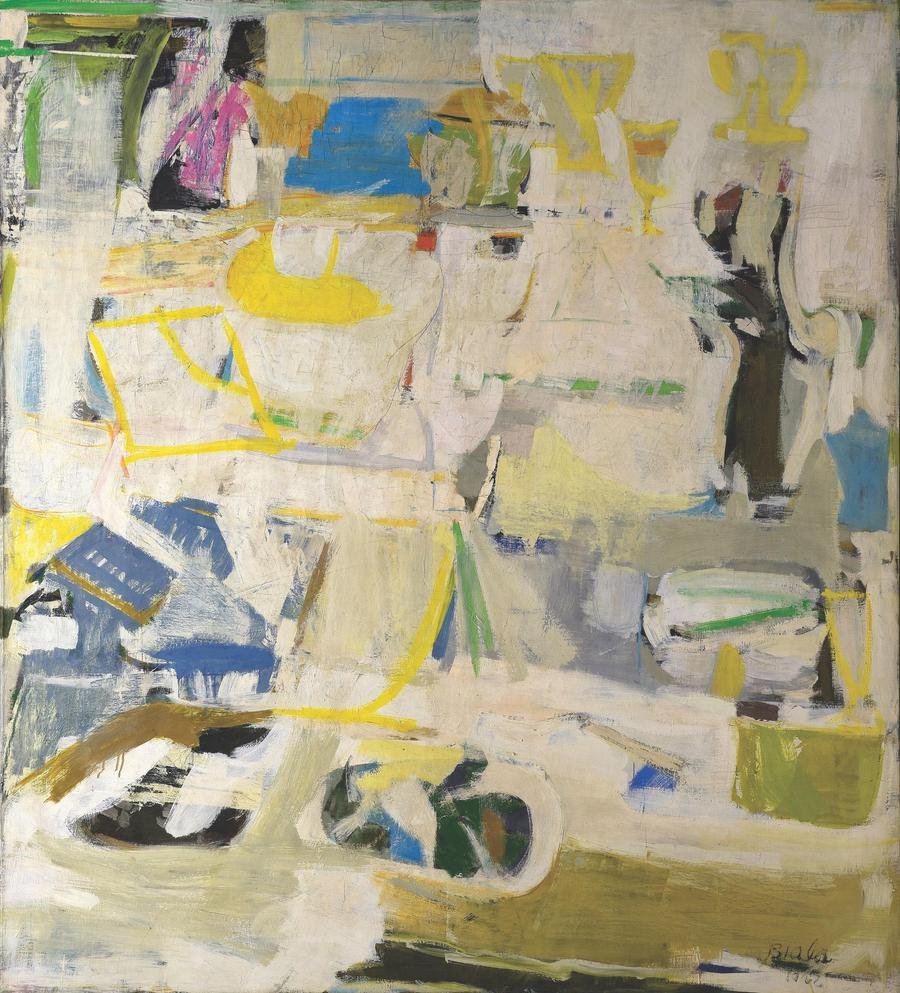Review (via de Tagesspiegel): Malen im Hier und Jetzt
Installation featuring Untitled (Three Glasses) 1962 by Janice Biala in Die Form der Freiheit: Internationale Abstraktion nach 1945 (The Form of Freedom: International Abstraction after 1945). Museum Barberini, Potsdam, Germany, June 4-September 25, 2022. Image: Courtesy Museum Barberini
Painting in the here and now
by Fernhard Schulz
The prelude is a painting in light tones by Janice Biala. Born in 1903 in Poland, which was then part of Russia, she emigrated to the USA with her family in 1913. In 1952 she painted the picture that is now displayed so prominently in the Museum Barberini in Potsdam.
Her name is not among those mentioned in connection with post-war American art. Just as little as that of Hedda Sterne, whose dark-colored painting "NY #7" was created in 1955 and hung nearby. Only the small-format works by Jackson Pollock on the left (“The Teacup”, 1946) and Arshile Gorky on the right (“Pastorale”, 1945), who died early, provide support for the memory.
Rediscovered Artists
The start is program. With the exhibition entitled “The Form of Freedom”, curator Daniel Zamani wants to present “International Abstraction after 1945”, from Europe and North America, and wants to tread well-trodden paths and leave them at the same time. Committing by presenting works by all the artists famous as abstract artists, such as Mark Rothko , Willem de Kooning or Barnett Newman, but leaving at the same time by adding those overlooked to the list of 52 participating artists. Most of them are female artists, of whom only a few, like Lee Krasner or Helen Frankenthaler, have achieved the same visibility in the art world.
Exhibition News (via Artful Daily): The Shape of Freedom: International Abstraction After 1945
The exhibition focuses on the two most important currents of abstraction following World War II: Abstract Expressionism in the United States and Art Informel in western Europe.
Janice Biala, Untitled (Still Life with Three Glasses), 1962. Oil and collage on canvas, 162,6 x 145,4 cm. Collection Richard and Karen Duffy, Chicago. © VG Bild-Kunst, Bonn 2022 Image: McCormick Gallery, Chicago
Jackson Pollock, Composition No. 16, 1948. Oil on canvas 56,5 × 39,5 cm. Museum Frieder Burda, Baden-Baden © Pollock-Krasner Foundation / VG Bild-Kunst, Bonn 2022
The role of the artist, of course, has always been that of image-maker. Different times require different images. ... To my mind certain so-called abstraction is not abstraction at all. On the contrary, it is the realism of our time. - Adolph Gottlieb, 1947
The Shape of Freedom: International Abstraction after 1945 is a major new traveling exhibition debuting at the Museum Barberini, in Potsdam, Germany, on June 4, 2022.
The exhibition focuses on the two most important currents of abstraction following World War II: Abstract Expressionism in the United States and Art Informel in western Europe. The Shape of Freedom is the first exhibition to explore this transatlantic dialogue in art from the mid-1940s to the end of the Cold War.
The show comprises around 100 works by over 50 artists including Sam Francis, Helen Frankenthaler, K. O. Götz, Georges Mathieu, Lee Krasner, Ernst Wilhelm Nay, Mark Rothko, Jackson Pollock, Judit Reigl, and Clyfford Still. Works on loan come from over 30 international museums and private collections including the Kunstpalast Düsseldorf, the Tate Modern in London, the Museo nacional Thyssen-Bornemisza in Madrid, the Metropolitan Museum of Art and the Whitney Museum of American Art in New York, the Centre Pompidou in Paris, the Peggy Guggenheim Collection in Venice, and the National Gallery of Art in Washington, DC.
After its opening run in Potsdam, a version of the exhibition will travel to the Albertina modern in Vienna (opening October 15, 2022) and then the Munchmuseet in Oslo.
Ortrud Westheider, Director of the Museum Barberini, Potsdam, said, “The paintings in the exhibition bear witness to the tremendous longing for artistic freedom that emerged on both sides of the Atlantic after 1945. The Hasso Plattner Collection, with important works by Norman Bluhm, Joan Mitchell, and Sam Francis, served as our point of departure. The concept developed by our curator Daniel Zamani was so convincing that the Albertina modern in Vienna and the Munchmuseet in Oslo agreed to host the exhibition as well. I am delighted to see this European cooperation.”
World War II was a turning point in the development of modern painting. The presence of exiled European avant-garde artists in America transformed New York into a center of modernism that rivaled Paris and set new artistic standards. In the mid-1940s, a young generation of artists in both the United States and Europe turned their back on the dominant stylistic directions of the interwar years. Instead of figurative painting or geometric abstraction they embraced a gestural, expressive handling of form, color, and material—a radically experimental approach that transcended traditional conceptions of painting. Artists like Jackson Pollock, Lee Krasner, Willem de Kooning, Franz Kline, Hans Hofmann, and Joan Mitchell discovered an intersubjective form of expression in action painting, while the color field painting of Mark Rothko, Barnett Newman, Adolph Gottlieb, Robert Motherwell, and Clyfford Still presented viewers with an overwhelming visual experience.









